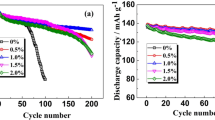Abstract
Long-term cycle life and high safety are important performances of lithium-ion power batteries. Voltage windows have a significant impact on battery cycle life and safety. While the mechanism by which an upper cut-off voltage affects the performances of lithium-ion batteries has been extensively studied, the effect of a lower cut-off voltage (LCV) on the cycle life and safety of lithium-ion batteries, especially nickel-rich layered oxide/graphite–SiOx batteries, is poorly understood. In this work, the as-prepared LiNi0.8Co0.1Mn0.1O2/graphite–SiOx pouch batteries have been cycled with different LCVs. When LCVs increase from 2.80 to 3.00 V, the capacity retention of the batteries increases from 90.66 to 93.98% in the 500 cycles, and the average temperature rise in discharging process decreases from 11.3 to 9.1 °C at the second stage. The resistance of batteries reduces because of the increase of LCVs, resulting in the decreased temperature rise and side reaction of the batteries. The increase of LCVs of batteries will be conducive to improving the cycle life and safety of batteries. This study provides a new direction for selecting voltage windows of batteries and a new idea for improving cycle and safety performances of batteries.






Similar content being viewed by others

References
Zhang K, Han X, Hu Z, Zhang X, Tao Z, Chen J (2015) Nanostructured Mn-based oxides for electrochemical energy storage and conversion. Chem Soc Rev 44(3):699–728
Sun G, Yu FD, Que LF, Deng L, Wang MJ, Jiang YS, Shao G, Wang ZB (2019) Local electronic structure modulation enhances operating voltage in Li-rich cathodes. Nano Energy 66:104102
Jung R, Strobl P, Maglia F, Stinner C, Gasteiger HA (2018) Temperature dependence of oxygen release from LiNi0.6Mn0.2Co0.2O2 (NMC622) cathode materials for Li-ion batteries. J Electrochem Soc 165(11):A2869–A2879
Wang L, Zhang B, Pang J, Liu Y, Wang X, Chang Z, Lu S (2018) Aging process analysis of LiNi0.88Co0.09Al0.03O2/graphite–SiOx pouch cell. Electrochim Acta 286:219–230
Li H, Liu A, Zhang N, Wang Y, Yin S, Wu H, Dahn JR (2019) An unavoidable challenge for Ni-rich positive electrode materials for lithium-ion batteries. Chem Mater 31(18):7574–7583
Xia H, Liu C, Shen L, Yu J, Li B, Kang F, He Y-B (2020) Structure and thermal stability of LiNi0.8Co0.15Al0.05O2 after long cycling at high temperature. J Power Sources 450:227695
Michan AL, Divitini G, Pell AG, Leskes M, Ducati C, Grey CP (2016) Solid electrolyte interphase growth and capacity loss in silicon electrodes. J Am Chem Soc 138(25):7918–7931
Delpuech N, Dupre N, Moreau P, Bridel JS, Gaubicher J, Lestriez B, Guyomard D (2016) Mechanism of silicon electrode aging upon cycling in full lithium-ion batteries. ChemSusChem 9(8):841–848
Zhao L, He Y-B, Li C, Jiang K, Wang P, Ma J, Xia H, Chen F, He Y, Chen Z, You C, Kang F (2019) Compact Si/C anodes fabricated by simultaneously regulating the size and oxidation degree of Si for Li-ion batteries. J Mater Chem A 7(42):24356–24365
Eom K, Joshi T, Bordes A, Do I, Fuller TF (2014) The design of a Li-ion full cell battery using a nano silicon and nano multi-layer graphene composite anode. J Power Sources 249:118–124
Liu H, Wolf M, Karki K, Yu YS, Stach EA, Cabana J, Chapman KW, Chupas PJ (2017) Intergranular cracking as a major cause of long-term capacity fading of layered cathodes. Nano Lett 17(6):3452–3457
Li J, Glazier SL, Nelson K, Ma X, Harlow J, Paulsen J, Dahn JR (2018) Effect of choices of positive electrode material, electrolyte, upper cut-off voltage and testing temperature on the life time of lithium-ion cells. J Electrochem Soc 165(13):A3195–A3204
Harlow JE, Ma X, Li J, Logan E, Liu Y, Zhang N, Ma L, Glazier SL, Cormier MME, Genovese M, Buteau S, Cameron A, Stark JE, Dahn JR (2019) A wide range of testing results on an excellent lithium-ion cell chemistry to be used as benchmarks for new battery technologies. J Electrochem Soc 166(13):A3031–A3044
Fan XP, Ding JX, Guo XB, Liu XJ (2012) Influences of terminal voltage on cycle performance of Li-ion battery. Bat Bimon 42(6):330–332
Wang L, Zhang B, Hu Y, Li X, Zhao T (2021) Failure analysis of LiNi0.83Co0.12Mn0.05O2/graphite–SiOx pouch batteries cycled at high temperature. J Power Sources 482:228978
Xia J, Ma L, Dahn JR (2015) Improving the long-term cycling performance of lithium-ion batteries at elevated temperature with electrolyte additives. J Power Sources 287:377–385
Li X, Qian K, He Y-B, Liu C, An D, Li Y, Dong Z, Lin Z, Li B, Yang Q-H, Kang F (2017) A dual-functional gel-polymer electrolyte for lithium ion batteries with superior rate and safety performances. J Mater Chem A 5(35):18888–18895
Bizeray AM, Zhao S, Duncan SR, Howey DA (2015) Lithium-ion battery thermal-electrochemical model-based state estimation using orthogonal collocation and a modified extended Kalman filter. J Power Sources 296:400–412
Liu C, Qian K, Lei D, Li B, Kang F, He Y-B (2018) Deterioration mechanism of LiNi0.8Co0.15Al0.05O2/Graphite-SiOx power batteries under high temperature and discharge cycling. J Mater Chem A 6(1):65–72
Zhao GJ, Xu F (2018) A study on the performance of NCA Li-ion batteries at high temperature. Chinese J Power Sources 42(5):624–626
Funding
This work was funded by the National Key Research and Development Program of China (Grant No. 2018YFB0104400).
Author information
Authors and Affiliations
Corresponding author
Additional information
Publisher’s note
Springer Nature remains neutral with regard to jurisdictional claims in published maps and institutional affiliations.
Rights and permissions
About this article
Cite this article
Wang, L., Zhang, B., Hu, Y. et al. Effect of lower cut-off voltage on LiNi0.8Co0.1Mn0.1O2/graphite–SiOx pouch battery. J Solid State Electrochem 25, 1743–1751 (2021). https://doi.org/10.1007/s10008-021-04948-4
Received:
Revised:
Accepted:
Published:
Issue Date:
DOI: https://doi.org/10.1007/s10008-021-04948-4



